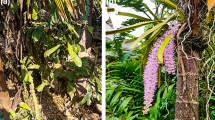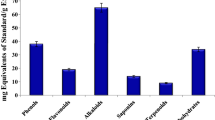Abstract
Due to the increase in exposure to chemical substances, the investigation of natural compounds with protective effects has become popular. So in this study the antimicrobial, antioxidant, antimutagenic activities and enzyme inhibitory effects of Trachystemon orientalis leaf and stem extracts were investigated. Antimicrobial effect was determined by disc diffusion method and the antimutagenic effect was investigated by Ames/Salmonella/microsomal test. Antioxidant properties of T. orientalis extracts were determined by investigating the phytochemical contents and 2,2-diphenyl-1-picrylhydrazyl (DPPH) removal activity. The antidiabetic activity of the extracts was investigated by α-amylase and α-glucosidase enzyme inhibition. It has been determined that all extracts exhibit antimicrobial activity at different ratios and the highest antimicrobial activity was obtained with a 21 ± 0.4 mm inhibition zone against Escherichia coli. The highest DPPH removal activity of leaf and stem extracts was determined to be 65.1 ± 2.4% and 59.4 ± 2.7%, respectively. In enzyme inhibitory analysis, it was determined that the α-glucosidase inhibitory effect of extracts was higher than the α-amylase inhibition effect. In antimutagenity test, the highest antimutagenic effects of leaf and stem extract were determined as 78.2 ± 1.1% and 67.2 ± 1.5%, respectively. As a result, T. orientalis leaf and stem extracts were determined as a potential natural antimicrobial, antimutagenic and antioxidant source with a moderately high antidiabetic activity.





Similar content being viewed by others
Abbreviations
- ACE:
-
Acarbose equivalent
- BHA:
-
Butylated hydroxytoluene
- BHT:
-
Butylated hydroxyanisole
- DPPH:
-
2,2-diphenyl-1-picrylhydrazyl
- GAE:
-
Gallic acide equivalent
- QAE:
-
Quillaja equivalent
References
C.M. Stein, Clin. Pharmacol. Ther. 71, 411–423 (2002)
M.C. Navarro, M.P. Montilla, M.M. Cabo, M. Galisteo, A. Cáceres, C. Morales, I. Berger, Phytother. Res. 17, 325–329 (2003)
O.E. Akcin, N. Kandemir, Y. Akcin, Turk. J. Bot. 28, 435–442 (2004)
A. Onaran, M. Yılar, J. Food Agric. Environ. 10, 287–291 (2012)
M. Yılar, A. Onaran, Y. Yanar, S. Belguzer, I. Kadıoglu, Iğdır Univ. J. Inst. Sci. Technol. 4, 19–27 (2014)
S. Karolina, P. Beata, P. Elżbieta, M. Anna, A.M. Waszkielewicz, J. Appl. Genet. 55, 273–285 (2014)
M. Jung, M. Park, H.C. Lee, Y.H. Kang, E.S. Kang, S.K. Kim, Curr. Med. Chem. 13, 1203–1218 (2006)
U. Etxeberria, A.L. Garza, J. Campión, J.A. Martinez, F.I. Milagro, Expert Opin. Ther. Targets 16, 269–297 (2012)
M. Bhat, S.S. Zinjarde, S.Y. Bhargava, A.R. Kumar, B.N. Joshi, J. Evid Based Complement. Altern. Med. 2011, 1–6 (2011)
E. Yalçın, E. Azap, K. Çavuşoğlu, Duzce Univ. J. Sci. Technol. 5, 622–631 (2017)
V.L. Singleton, J.A. Rossi, Am. J. Enol. Viticult. 16, 144–158 (1965)
J. Zhishen, T. Mengcheng, W. Jianming, Food Chem. 64, 555–559 (1999)
W. Vermerris, R. Nicholson, in Isolation and Identification of Phenolic Compounds. Phenolic Compound Biochemistry, (Springer, Dordrecht, 2008), pp 151–196.
A. Aktumsek, G. Zengin, G.O. Guler, Y.S. Cakmak, A. Duran, Food Chem. Toxicol. 55, 290–296 (2013)
G.C. Yen, P.D. Duh, J. Agric. Food Chem. 42, 629–632 (1994)
D.M. Maron, B.N. Ames, Mutat. Res. 113, 173–215 (1983)
A. Mocan, G. Zengin, A. Uysal, E. Gunes, A. Mollica, N.S. Degirmenci, L. Alpsoy, A. Aktumsek, J. Funct. Foods 25, 94–109 (2016)
O. Sacan, Eur. J. Biol. 77, 70–75 (2018)
M.C. Ayvaz, Turkey Herba Pol. 61, 40–51 (2015)
S. Mamta, S. Jyoti, N. Rajeev, S. Dharmendra, G. Abhishek, J. Pharmacogn. Phytochem. 1, 168–182 (2013)
A.B. Aliyu, A.M. Musa, M.S. Abdullahi, M.A. Ibrahim, M.B. Tijjani, M.S. Aliyu, A.O. Oyewale, J. Med. Plant Res. 5, 6709–6713 (2011)
A. Scalbert, Phytochemistry 30, 3875–3883 (1991)
K. Asakura, S. Matsumura, S. Yoshikawa, K. Kawada, T. Uchibori, J. Am. Oil Chem. Soc. 66, 1450–1453 (1989)
K.H. Kwon, A. Barve, S. Yu, M.T. Huang, A.N.T. Kong, Acta Pharmacol. Sin. 28, 1409–1421 (2007)
Y.J. Surh, Nat. Rev. Cancer 3, 768–780 (2003)
A.R. Francis, T.K. Shetty, R.K. Bhattacharya, Mutat. Res. 222, 393–401 (1989)
M. Masoumi, S. Mehrabian, M.K. Rahimi, F. Bagheri, H. Masoumi, Res. J. Pharm. Biol. Chem. Sci. 5, 1311–1319 (2014)
R. Saad, M. Aqil, E. Yusuf, F. Asmani, IJPAR 3, 241–248 (2014)
Author information
Authors and Affiliations
Corresponding author
Ethics declarations
Conflict of interest
The present study does not constitute endorsement of the product by the authors or any conflict of interest.
Research involving human and animal participants
This article does not contain any studies with human or animal subjects.
Additional information
Publisher's Note
Springer Nature remains neutral with regard to jurisdictional claims in published maps and institutional affiliations.
Rights and permissions
About this article
Cite this article
Ayhan, B., Yalçın, E., Çavuşoğlu, K. et al. Antidiabetic potential and multi-biological activities of Trachystemon orientalis extracts. Food Measure 13, 2887–2893 (2019). https://doi.org/10.1007/s11694-019-00209-1
Received:
Accepted:
Published:
Issue Date:
DOI: https://doi.org/10.1007/s11694-019-00209-1




